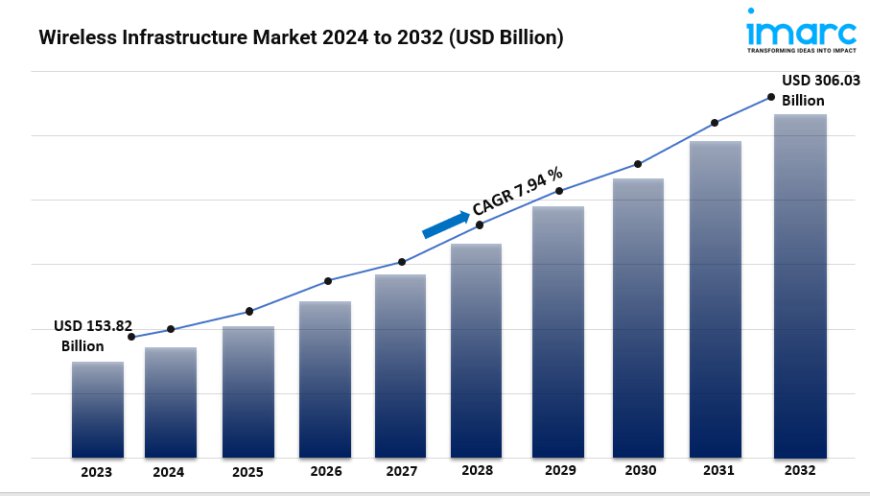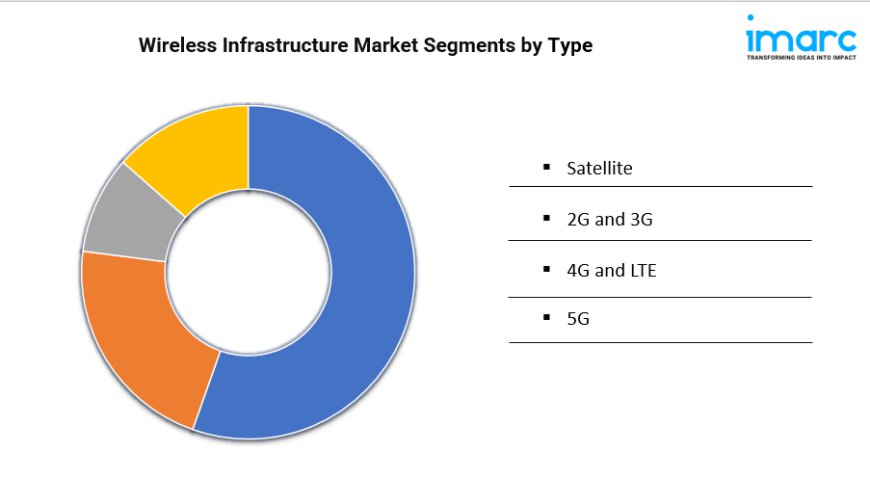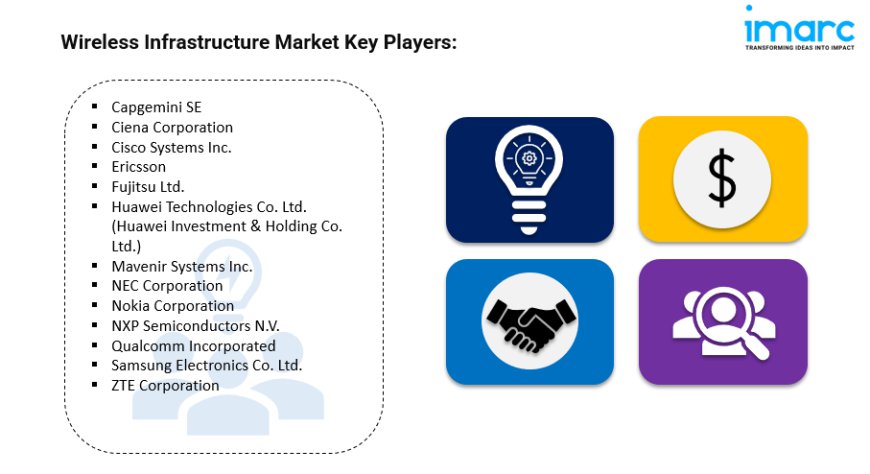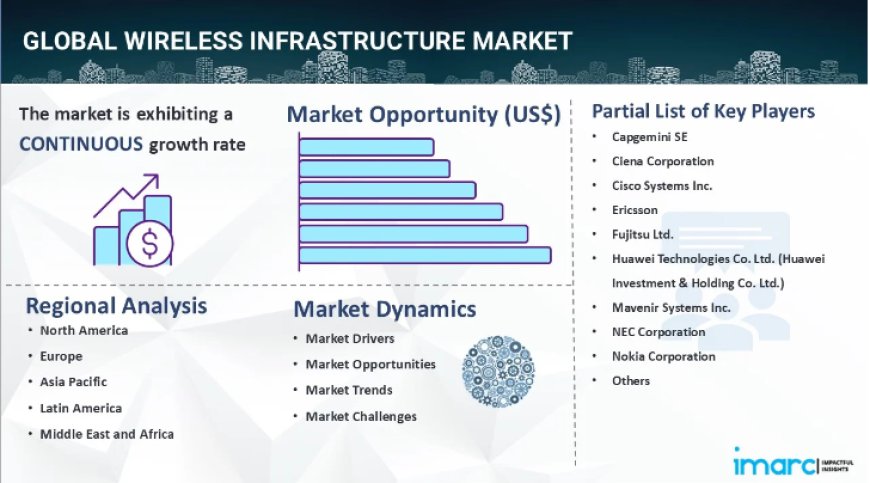Wireless Infrastructure Market Size, Industry Trends, Share, Growth & Forecast Report 2024-2032
The global wireless infrastructure market size reached USD 153.82 Billion in 2023. We expect the market to reach USD 306.03 Billion by 2032.
Summary:
- The global wireless infrastructure market size reached USD 153.82 Billion in 2023.
- The market is expected to reach USD 306.03 Billion by 2032, exhibiting a growth rate (CAGR) of 7.94% during 2024-2032.
- North America leads the market, accounting for the largest wireless infrastructure market share.
- 5G (fifth generation) accounts for the majority of the market share in the type segment due to their growing adoption as they offer widely advanced features, such as faster data rates, lower latency, and more connection.
- Commercial holds the largest share in the wireless infrastructure industry.
- Distributed antenna systems (DAS) remain a dominant segment in the market, due to their burgeoning use in enhancing cellular connectivity in extensive, complex environments such as large corporate buildings, stadiums, and hospitals.
- The growing emphasis on digital transformation across industries, further accelerating the demand for modern wireless infrastructure.
- The increasing investments by governments and private companies in telecommunications infrastructure to improve network coverage and quality are fueling the market growth.

Request to Get the Sample Report: https://www.imarcgroup.com/wireless-infrastructure-market/requestsample
Industry Trends and Drivers:
- Increasing Demand for High-Speed Internet and Enhanced Mobile Connectivity
The growing global reliance on digital communication has significantly increased the demand for high-speed internet and enhanced mobile connectivity, which are crucial drivers of the wireless infrastructure market. As consumers and businesses use more data-heavy applications, such as video streaming, online gaming, and cloud-based services, the need for reliable and fast wireless networks has become more pressing.
The expansion of mobile broadband services and the rise in the number of connected devices have led to a surge in data traffic, necessitating advancements in wireless infrastructure to prevent network congestion and ensure seamless connectivity. This demand is further amplified by the need for uninterrupted service in both urban and rural areas, prompting telecom providers to invest in upgrading their existing infrastructure and deploying new technologies that can handle the increased data load efficiently.
- Rollout of 5G Technology
The rollout of 5G technology is a transformative force in the wireless infrastructure market, driving substantial upgrades and investments. Unlike its predecessors, 5G offers significantly higher speeds, reduced latency, and the ability to connect more devices simultaneously, which necessitates comprehensive changes to current network infrastructures.
To support 5G, telecom companies are required to implement advanced hardware like small cells, massive MIMO (Multiple Input Multiple Output) antennas, and new frequency bands. This rollout is not just about improving mobile internet speeds; it is about enabling new use cases, such as autonomous vehicles, smart cities, and advanced IoT applications that require ultra-reliable and low-latency communication.
- Rise of the Internet of Things (IoT)
The rise of the Internet of Things (IoT) is another critical driver of the global wireless infrastructure market, as it significantly expands network demands across various industries. IoT refers to the growing network of connected devices that communicate and exchange data without human intervention, ranging from smart home devices and wearable technology to industrial sensors and smart city infrastructure.
As more devices come online, the need for reliable and expansive wireless networks becomes paramount to support seamless connectivity and data transfer. This increased demand is pushing telecom companies to enhance their infrastructure to handle a massive influx of devices and ensure low latency and high reliability. Furthermore, IoT applications often require widespread coverage and robust connections, particularly in sectors like healthcare, transportation, and manufacturing, where real-time data transmission is crucial.
Speak to An Analyst: https://www.imarcgroup.com/request?type=report&id=19659&flag=C
Wireless Infrastructure Market Report Segmentation:
Breakup By Type:
- Satellite
- 2G and 3G
- 4G and LTE
- 5G
The 5G segment was the largest because of the accelerated global rollout of 5G networks and the increasing demand for high-speed, low-latency connectivity to support emerging technologies and applications.

Breakup By Platform:
- Government and Defense
- Commercial
The commercial platform segment was the largest due to the significant investments by businesses and enterprises in enhancing network capabilities to support digital transformation, remote work, and advanced applications.
Breakup By Infrastructure:
- Macrocell Radio Access Networks (RAN)
- Small Cells
- Remote Radio Heads (RRH)
- Distributed Antenna Systems (DAS)
- Cloud RAN
- Carrier Wi-Fi
- Mobile Core
- Backhaul
Distributed Antenna Systems (DAS) were the largest segment due to their widespread adoption in improving wireless coverage and capacity in large venues and densely populated areas.
Breakup By Region:
- North America
- United States
- Canada
- Europe
- Germany
- France
- United Kingdom
- Italy
- Spain
- Others
- Asia Pacific
- China
- Japan
- India
- South Korea
- Australia
- Indonesia
- Others
- Latin America
- Brazil
- Mexico
- Others
- Middle East and Africa
North America was the largest market because of its advanced telecommunications infrastructure, early adoption of new technologies like 5G, and significant investments from key industry players.
Top Wireless Infrastructure Market Leaders: The wireless infrastructure market research report outlines a detailed analysis of the competitive landscape, offering in-depth profiles of major companies. Some of the key players in the market are:
Some of the key players in the market are:
- Capgemini SE
- Ciena Corporation
- Cisco Systems Inc.
- Ericsson
- Fujitsu Ltd.
- Huawei Technologies Co. Ltd. (Huawei Investment & Holding Co. Ltd.)
- Mavenir Systems Inc.
- NEC Corporation
- Nokia Corporation
- NXP Semiconductors N.V.
- Qualcomm Incorporated
- Samsung Electronics Co. Ltd.
- ZTE Corporation

If you require any specific information that is not covered currently within the scope of the report, we will provide the same as a part of the customization.
About Us:
IMARC Group is a global management consulting firm that helps the world’s most ambitious changemakers to create a lasting impact. The company provide a comprehensive suite of market entry and expansion services. IMARC offerings include thorough market assessment, feasibility studies, company incorporation assistance, factory setup support, regulatory approvals and licensing navigation, branding, marketing and sales strategies, competitive landscape and benchmarking analyses, pricing and cost research, and procurement research.
Contact US:
IMARC Group
134 N 4th St. Brooklyn, NY 11249, USA
Email: sales@imarcgroup.com
Tel No: (D) +91 120 433 0800
United States: +1–631–791–1145

 businessnews
businessnews 